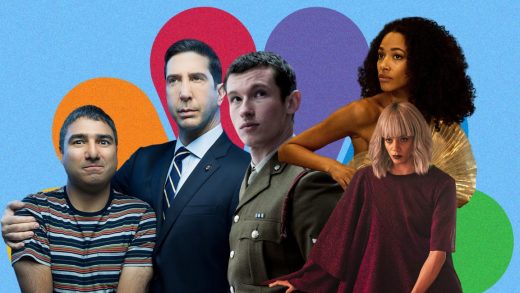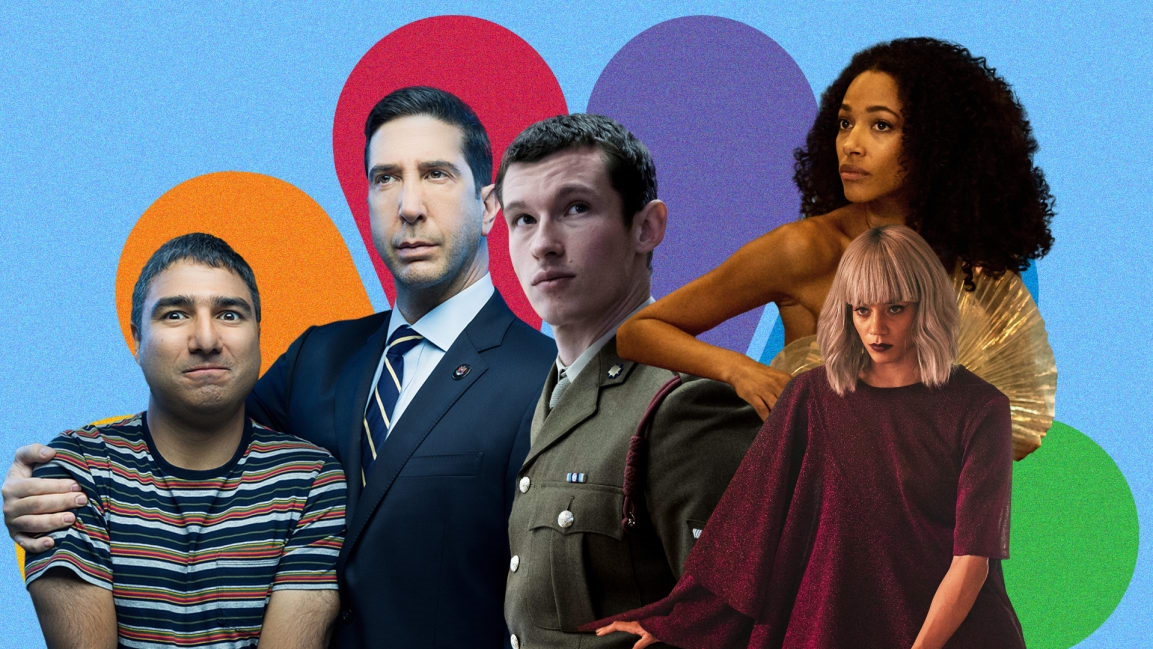Peacock struts into the streaming wars touting what makes it different
Peacock has entered the chat—and it might actually have something to contribute.
As the last of the presumed major streaming services to launch, Peacock is staring down a crowded playing field with where Netflix and Disney Plus have established themselves as the clear frontrunners. Being the O.G. streaming platform, Netflix has accrued a staggering 183 million subscribers worldwide. Disney, in addition to its extensive back catalogue, has dropped several buzzy projects onto its still only eight-and-a-half months old service, including The Mandalorian, Hamilton, and the early release of Pixar’s Onward, with Beyoncé’s upcoming visual album Black is King coming July 31. These have given the platform a stronger foothold in the content and subscriber game than other newcomers such Apple TV Plus, Quibi, and HBO Max.
But to hear Peacock chairman Matt Strauss tell it, his intention isn’t to storm the battlefield with domination in mind.
“I think the streaming wars is a bit of a misnomer,” he says. “It’s about giving consumers choice.”
And he doesn’t mean just choices in content.
Peacock is launching with distinctive features and a free, ad-supported tier that Strauss hopes could be enough for the platform to gain some traction out of the gate—especially since the COVID-19 pandemic scrapped plans of a big push from the summer Olympics and halted production on several original programs. Peacock is also slightly disadvantaged at the moment given the fact that it has yet to secure distribution deals with Roku or Amazon TV, two of the biggest connected TV services in the market.
But Strauss remains bullish on where Peacock stands at launch.

[Photo: Brian Doben/NBCUniversal]
“I’ve had a front-row seat at understanding consumer behavior and certainly the technology that’s shaped a lot of the consumer behavior,” Strauss says of his prior leadership and management roles across Comcast, Xfinity, and Disney-ABC. “There was one consistent thing: Consumers always wanted more choice. They wanted more choice over what they paid for. They wanted more choice over how they access their content. That was something that went into the calculus when we were designing and developing Peacock.”
Rethinking what it means to be free
A key component of Peacock’s strategy is its tiered subscription model. Its first premium tier is $4.99 per month that includes ads but with access to all content. For $9.99, there are no ads. And there’s also the free tier with a limited library of content and ads.
Free, ad-supported services have become something of a hot commodity within the larger streaming wars, with Fox and Viacom acquiring Tubi and Pluto TV, respectively. However, it’s a model that has yet to translate well within the structure of a typical streaming service.
Hulu built its following on a free, ad-supported model but nixed the option in 2016 as the company began to double down on original programming. Hulu’s former head of experience Ben Smith said at the time that “the free service became very limited and no longer aligned with the Hulu experience or content strategy.”
“There’s always a market for someone who doesn’t or can’t afford to pay for streaming, especially now with the economy being a little rockier, but I just don’t think that’s a long-term viable strategy,” says Marc Randolph, a Netflix cofounder and its first CEO. “A freemium business is always undergirded by the people who are willing to pay the full boat. So yes, it’s a great way to get people to watch, but to get them to stick, you need to move them to a paying version.”
However, Strauss seems committed to making every tier on Peacock an attractive option both in terms of content and creating a less intrusive ad experience.
“We certainly know there is a segment that is willing to pay money for more, but we also don’t want to make somebody feel like they have to,” he says. “You can still get a good experience that’s free.”
Peacock’s premium tiers have more than 20,000 hours of content, while its free option has a respectable 13,000. (By comparison, when HBO Max was first unveiled, it promised 10,000 hours of content. Its service costs $15 a month.) Deciding what TV shows and films go behind its paywall comes down to a combination of third-party rights, consumer research, and human curation. As far as ads are concerned, Peacock limits it to a maximum of five minutes of commercials per hour, compared to an average of 16 minutes in linear TV. For films on Peacock, ads are front-loaded before the movie starts so there are no further interruptions. (Tubi, for example, does run ad blocks during films.)
“It’s about how do we explore continuing to evolve the product in a way where the ads could be more endemic to your overall experience and as opposed to it being seen as a tax for getting access to content?” Strauss says. “Out of the gate, a very light ad load is demonstrating we’re putting our money where our mouth is.”
Streaming, but mimic what people like about live TV
“One of the things that I always found fascinating when I ran the video business at Comcast is that on-demand is no question lightning in a bottle—this is how people want to consume television,” Strauss says. “Yet the average person spends about five hours a day consuming video, and the vast majority of that consumption is linear.”
That research became the basis for Channels, a feature within Peacock that allows viewers to scroll through a grid of curated TV shows, news, and sports that mimics live TV. For example, if you click on the SNL Vault or Unsolved Mysteries channels, there’ll be a sketch or episode playing that you may catch midway through.
“There’s something about just wanting to turn on the television and lean back and flip through channels,” Strauss says. “There’s a serendipity to it. There are points in time where people just like to have video playing on in the background. There are certainly points of time where you don’t always know what you want to watch.”
Peacock currently has around 30 channels, but Strauss says they’re aiming for 70 by the end of the year. He also mentions that down the line, there will be more dynamic control options to pause and rewind within Channels or redirect to full episodes. Strauss acknowledges that Channels won’t be a hit with everyone. The Comcast customers who had a three-month trial run with Peacock prior to launch, for example, weren’t fans. “That kind of makes sense, because if you’re a paid TV customer, you’ve already got lots of channels,” he says. “But when we looked at the flex customers, which are internet-only customers, the usage there was 10 times higher.”
“Our ambition is not to necessarily serve everybody equally. It’s about personalization,” he continues. “It’s about getting the right choice to the right user at the right moment in time.”
Even with Channels as just an option, Randolph is skeptical of it being a feature that truly sticks.
“I’m a big believer in testing and following what you find,” he says of Peacock’s research with Comcast users. “But it’s hard to imagine that that is anything more than legacy behavior and that little by little, that’s going to start fading out.”
Bringing social to streaming
Another distinctive feature of Peacock is its Trending tab. Users can scroll through clips that update accordingly, including sports highlights and breaking news.
“There are things that are happening that are timely, and you don’t really think of a streaming service as where you would go to get the pulse of television,” Strauss says. “This is where you’re seeing the ambition of Peacock is bigger in some respects than other streaming services, because we’re trying to do all three. We’re trying to be an on-demand service, a lean-back linear service, and also bring that pulse of currency into streaming as well.”
Like Channels, Strauss acknowledges that Trending won’t be for everyone, with research pointing to consumers split 50/50 on liking and disliking the feature. But as with Channels, Strauss says that they plan to continue to iterate in order to make the offering as personalized as possible.
“We’re trying to appeal to everybody, and to appeal to everybody, you’ve got to provide more choices,” Strauss says. “We want to build the sophistication to get to a place where we can get more personalized. We’re not there yet, but I think that you’ve got to appreciate the bigger picture of trying to take on something more ambitious, of trying to build a product and a service and experience that’s really meant to become more attuned to an individual.”
Ultimately, Peacock is taking commendable swings to differentiate itself in the marketplace, something that both Apple TV Plus and HBO Max have thus far failed to do. It has the framework of a streaming platform that cord-cutters are used to but features that lean into linear and social in a way that show potential. Plus, its free, ad-supported tier actually has a decent library of content that will be a serviceable complement for users that have hit their budgetary limits with streaming services they’re currently paying for.
“There’s a position for a streaming service like Peacock,” Randolph says. “These aren’t stupid people. There’s a lot of smart folks there. And if they had said, ‘What is the streaming service we would want to design if we were the first to enter?’ I’m not sure they may have picked this way. But they’re playing the hand they’re dealt.”
“We’ve got a very long-term vision for Peacock,” Strauss says. “What you’re really looking at is us putting a flag in the sand. It’s the start of what’s going to become a much more robust evolution. It’s important to understand where we’re trying to head with it versus necessarily focusing on where it is at any one moment in time.”
(34)



